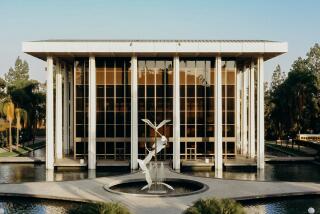You Know Where to Find Me, Oscar
Feeling like the scorned stepsister left behind on the night of the ball, the Shrine Auditorium will be dark and lonely when Hollywood’s stars gather Sunday at the new Kodak Theatre.
But like Cinderella, the Moorish-style landmark south of downtown Los Angeles is planning a make-over.
Leaders of the fraternal order that owns the 76-year-old auditorium have scheduled a $3-million upgrade that they hope will lure back Oscar and 6,300 of his friends.
The Al Malaikah Shrine will shut down the huge hall over the summer.
Workers will remove and reupholster its plush red theater seats and refurbish the auditorium and its adjoining exhibition hall.
Royal Street, outside the auditorium’s five arched front doors, will be closed off and converted into a landscaped plaza to form an entryway.
Shrine Auditorium operators say the changes will turn the hall into everything the Kodak isn’t: A venue that is as convenient to get into as it is comfortable to sit in, and is big enough for a show that is larger than life.
“I predict the Academy Awards will be back here next year,” said Tom Reoch, an administrator of the Al Malaikah Shrine. “I’m 99% certain they’ll be back after what they will see this coming weekend.”
Reoch’s confidence is sharpened by complaints that have already been lodged about the $94-million Kodak Theatre in Hollywood.
Music critics have drubbed the new auditorium’s acoustics. Motorists are grumbling about Hollywood Boulevard and Highland Avenue street closures prompted by Sunday’s Academy Awards show. Merchants are complaining about having their storefronts draped with camouflage cloth on the town’s biggest weekend of the year.
Film stars are wondering how they will negotiate a difficult walk into the theater in five-inch heels. Angriest of all are academy members who will be unable to get in: The new theater will only accommodate an audience of about 3,100 for the Oscar show.
The Shrine, supporters note, is America’s largest theater. Each of its 6,300 seats has an unobstructed view of what is the country’s biggest performance stage.
The auditorium was considered a triumph of architecture and civil engineering when it opened in 1926 after two years of construction. The concrete-walled structure cost $2.6 million and replaced a smaller 14-year-old temple that burned in 1920.
Its builders calculated that the Shrine’s 192-foot-wide domed roof weighs 1,870 tons. The theater’s proscenium, the arch that frames the stage curtain, is 100 feet wide.
Visitors came to gawk at the auditorium’s vast cantilevered balcony. It seemed to float without pillars beneath a five-ton crystal chandelier. The 28-foot-long fixture used 500 bulbs--and drew 62,445 watts when its red, white, blue and amber bulbs were lit.
The hall was called the Los Angeles Civic Auditorium at first because it was financed in part with stock sold to the public.
Later, the Ancient Arabic Order of Nobles of the Mystic Shrine repurchased all of the shares and renamed it.
For decades the auditorium was routinely booked for local events and used as a movie backdrop. It is in the original “King Kong” film.
In the late 1930s it became so popular as a site for jitterbug contests that police had to be called to control the crowds. During World War II the huge hall was filled with military servicemen and their dates for star-studded New Year’s Eve shows.
It was the setting for ballet, opera performances and religious services in the 1950s. USC and UCLA played basketball games on the 192-foot-wide, 72-foot-deep stage. Democratic presidential hopeful Adlai E. Stevenson drew a turn-away crowd of 6,700 when he gave a 1952 speech.
But the Shrine is best known for the high-profile awards shows held there. The Grammys, the American Music Awards, the Emmys and the Soul Train Awards have been televised from its stage. The Academy Awards--which first used the hall in 1947--alternated between there and the smaller Dorothy Chandler Pavilion from 1988 to last year.
Academy officials acknowledged that they relied on the Shrine’s seating capacity to handle a growing backlog of Oscar show ticket requests they could not handle at the pavilion.
Over the decades the hall has survived countless earthquakes, two riots and one airplane crash.
A secret, unpiloted Navy plane smashed into the Shrine’s roof near its southwest cupola and burned in 1945. No one was injured--but no one ever explained the mishap.
A computerized stage system was among improvements made in 1993 as part of a $15-million overhaul.
Reoch said Shriners were disappointed when the Motion Picture Academy signed with the Kodak Theatre for Sunday’s show. So Al Malaikah members will be closely observing how things go.
“One part of us will be wishing the academy all the best. After all, they represent Los Angeles and the United States to the world. We don’t want to see any foul-ups,” Reoch said. “But we’ll know if things go wrong. We’ll be watching.
“This auditorium is always elegant. But when the Oscars come, it’s magnificent. They’ll be back. I’m sure of that.”
More to Read
Sign up for Essential California
The most important California stories and recommendations in your inbox every morning.
You may occasionally receive promotional content from the Los Angeles Times.











